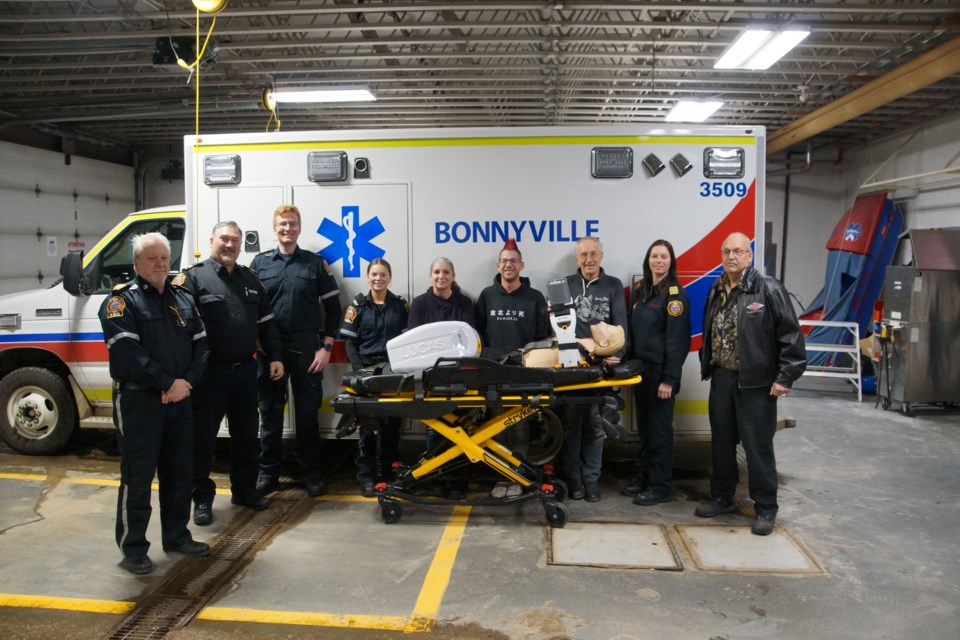BONNYVILLE – New life saving equipment has been added to Bonnyville Ambulance inventory thanks to purchases made by the Summer Village of Bonnyville Beach council.
Municipal Sustainability Initiative (MSI) grant funding provided by the Alberta government was used by the summer village’s council to purchase two e700 ventilators and three Stryker LUCAS 3 devices that provide mechanical chest compressions.
“Thanks to the flexibility of the Municipal Sustainability grant program, we were able to address a need that not only affects our Summer Village residents but all of the people who need an ambulance in the area,” Paul Tercier, the administrator for Bonnyville Beach, told Lakeland This Week.
This equipment will provide support for extended CPR and ventilation requirements when a responding ambulance is far from a hospital or emergency center, as well as when long distance transport is required to larger trauma centers in the province, explained Alicia Krawchuk, the Regional Deputy Fire Chief for the Bonnyville Regional Fire Authority (BRFA).
Before council decided to purchase these medical devices for the BRFA, conversations between the two groups took place to make sure the provincial funding would have the greatest impact and assist the most people, said Tercier.
“The council of the Summer Village of Bonnyville Beach is pleased to provide this support with the help of the Province of Alberta making it possible for the opportunity to enhance emergency medical services to our community,” expressed Mayor Grant Ferbey, on behalf of the Summer Village of Bonnyville Beach council.
While these specialized devices are not required to be in an ambulance, Krawchuk said the devices were chosen based on the unique needs of the Lakeland and the region's proximity to tertiary care.
“For example, the ventilators are used during long transports to Edmonton. A major consideration for purchasing the Lucas CPR devices was the extreme cold temperatures that we experience, and the risks of cold-water drownings,” she explained.
“Treating both hypothermic or cold-water drowning cardiac arrests can last for hours while practitioners work to increase the patient's body temperature. These CPR devices will eliminate provider fatigue and provide consistent compressions accurately... As the devices can mechanically perform CPR on the patient, a paramedic is free to assist in other ways, such as ventilating or giving medications.”
Krawchuk added that the BRFA is very grateful for the generous donation that the Summer Village of Bonnyville Beach provided.
The $75,000 grant was the result of research done by council, Mayor Ferbey and councillors Laurie Gardner and Tom Thackeray.
The MSI grant made it possible for council to provide the Bonnyville's EMS service with equipment that was outside of the health organization's budget, Tercier said.
“The emergency response equipment will help the Bonnyville Ambulance Service to better serve the people throughout the MD, when extended distances make the time for providing service longer,” he continued.
“Going beyond our boundaries to provide better results for our neighbours as well as our own residents is something that our council works towards.”
After the arrival of the medical equipment, Minister of Municipal Affairs Rebecca Schulz, provided the following statement: “I want to thank and congratulate the Summer Village of Bonnyville Beach for taking steps to ensure effective emergency services in the community. The goal of the Municipal Sustainability Initiative has always been to provide Alberta’s municipalities with the funding they need to improve the quality of life of their residents. This investment will help to equip our emergency first responders with the gear they need to do their jobs, help their fellow citizens and save lives.”
Equipment Training
Training on the new equipment took place on Dec. 13 at the Bonnyville Ambulance headquarters with local paramedics, and a visit from Ferbey.
When the BRFA received the LUCAS devices, a team from Stryker travelled to Bonnyville to train local paramedics on the devices.
“The devices are designed to provide mechanical ventilations and have multiple options for establishing precise ventilation parameters for each patient's needs,” Krawchuk explained.
In addition, a ventilator would complement resuscitation efforts and provide paramedics with the ability to focus on diagnostics and treatments in life-threatening emergencies.
“These units will assist our paramedics tremendously when responding to and treating patients in cardiac arrest,” she added.



